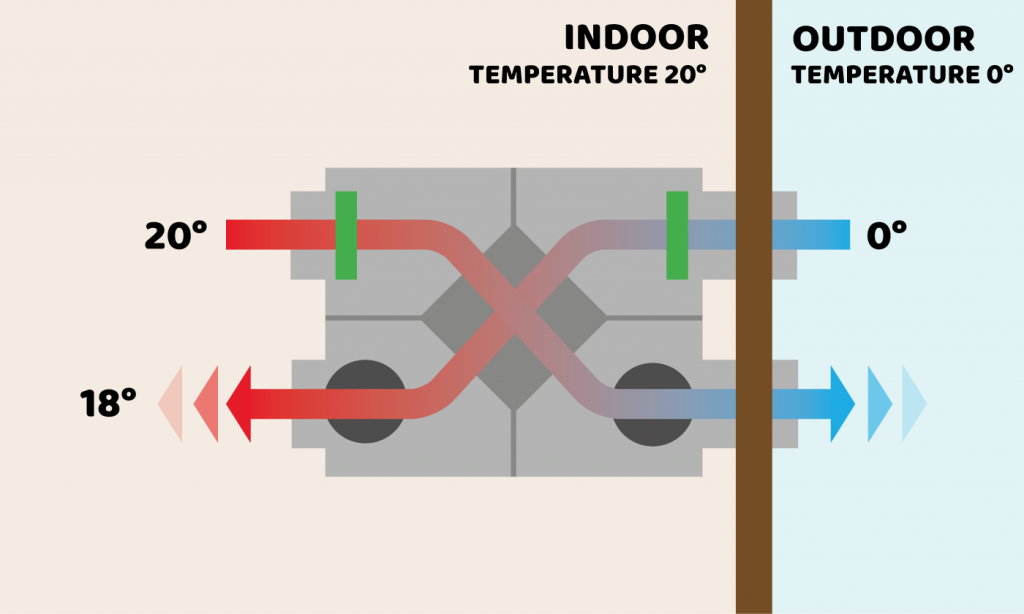Just How Heat Recovery Ventilation Enhances Indoor Air High Quality and Reduces Energy Prices
Heat Recovery Ventilation (HRV) systems play a vital role in enhancing interior air quality while at the same time decreasing power costs. By efficiently trading stale interior air with fresh outdoor air, HRVs aid preserve excellent humidity and reduce toxins. Additionally, their ability to recuperate warm from outgoing air decreases the stress on home heating and cooling down systems. As power prices remain to increase, understanding the complete possibility of HRV systems ends up being increasingly vital for homeowners and companies alike.
Recognizing Heat Recovery Ventilation Systems

Heat recovery ventilation (HRV) systems play a vital function in enhancing indoor air top quality, specifically in modern-day, energy-efficient structures. These systems are created to move heat from the outgoing stale air to the incoming fresh air, therefore decreasing power loss while maintaining optimal temperature level degrees indoors. HRVs are composed of a warmth exchanger, followers, and ductwork, promoting the continuous circulation of air. By getting rid of interior toxins and introducing fresh air, HRVs assist to stabilize humidity levels, protect against mold and mildew growth, and reduce irritants. The efficiency of HRV systems hinges on their capability to recuperate as much as 80% of the heat from the exhausted air, advertising energy conservation while ensuring a healthy and balanced interior setting. Their combination is essential in achieving sustainable living techniques.
The Relevance of Indoor Air High Quality
Indoor air quality (IAQ) is an essential aspect affecting the wellness and wellness of owners in any environment. Poor IAQ can result in different wellness issues, including breathing problems, allergic reactions, and tiredness. Additionally, it can exacerbate existing conditions such as asthma. Variables contributing to low IAQ consist of contaminants from indoor sources like cleaning up agents, mold, and inadequate air flow. Keeping good IAQ is essential for promoting a safe and comfortable living or functioning space. Reliable strategies to boost IAQ include regular surveillance of air high quality, correct air flow systems, and minimizing using hazardous compounds inside your home. By prioritizing IAQ, individuals can click for info assure a healthier environment that fosters efficiency and overall lifestyle.
Energy Effectiveness Perks of HRV Systems
Several home owners and structure managers are progressively recognizing the energy effectiveness benefits of warmth recovery air flow (HRV) systems. By transferring warm from exhausted indoor air to incoming fresh air, HRV systems substantially reduce the energy required for heating & cooling. This procedure decreases reliance on conventional heating and cooling systems, resulting in reduced power expenses. In addition, HRVs aid maintain a well balanced interior environment, protecting against excessive heating or cooling down demands. The capability to recuperate approximately 90% of the warm from outward bound air also supports sustainability initiatives by reducing general power consumption. HRV systems add not just to set you back savings yet additionally to a decreased carbon impact, aligning with the expanding emphasis on energy-efficient building practices.
Setup and Maintenance Considerations
The efficient implementation of warm recuperation air flow (HRV) systems needs careful factor to consider of installation and upkeep variables to guarantee peak efficiency. Appropriate positioning of the HRV unit is crucial, as it needs to be mounted in a place that takes full advantage of air flow while reducing noise interruption. Additionally, ductwork has to be properly sized and shielded to avoid energy loss. Routine upkeep, consisting of filter replacement and system cleansing, is vital to secure ideal capability and indoor air top quality. Owners ought to develop a normal upkeep timetable to identify and address prospective concerns before they intensify. Collaboration with seasoned experts throughout both installment and upkeep phases can enhance the durability and performance of HRV systems, eventually leading to better interior settings and minimized energy costs.
Real-World Applications and Success Stories
Checking out real-world applications of warm recuperation ventilation (HRV) systems reveals their substantial impact on indoor air top quality and power performance throughout numerous settings. In residential buildings, home owners have actually reported better air Click Here high quality, causing fewer allergies and respiratory concerns. Schools applying HRV systems have actually noted enhanced pupil concentration and lowered absenteeism as a result of better ventilation. Industrial buildings, such as workplaces and retail spaces, have experienced lower power expenses and enhanced staff member efficiency. A company workplace in a pleasant climate attained a 30% decrease in energy bills after mounting an HRV system. These success tales demonstrate that HRV innovation not only contributes to much healthier settings however likewise supplies tangible monetary benefits, making it a useful financial investment for various markets.
Frequently Asked Questions
Can HRV Equipments Decrease Allergens in Indoor Air?
The effectiveness of HRV systems in lowering interior irritants mostly depends upon their capacity to filter and exchange air. HRV Heat Recovery Ventilation. By continually replacing stagnant air, these systems can considerably lower allergen levels throughout interior settings

Just How Does Humidity Affect HRV System Performance?
Humidity considerably affects HRV system performance; high levels can result in condensation, reducing performance, while low humidity may boost air exchange. Stabilizing moisture is necessary for excellent operation and maintaining interior air top quality.
Are HRV Systems Noisy During Operation?
HRV systems can generate varying sound degrees throughout operation, relying on their style and setup. Some units operate silently, while others might create recognizable noise, specifically at greater airflow settings or when improperly maintained.
What Is the Typical Life-span of an HRV System?

Can HRV Solutions Be Used in All Climates?
HRV systems can be used in different environments, however their efficiency might vary - HRV Heat Recovery Ventilation. In severe temperature levels, adjustments or extra systems might be required to assure optimal efficiency and comfort while preserving interior air quality